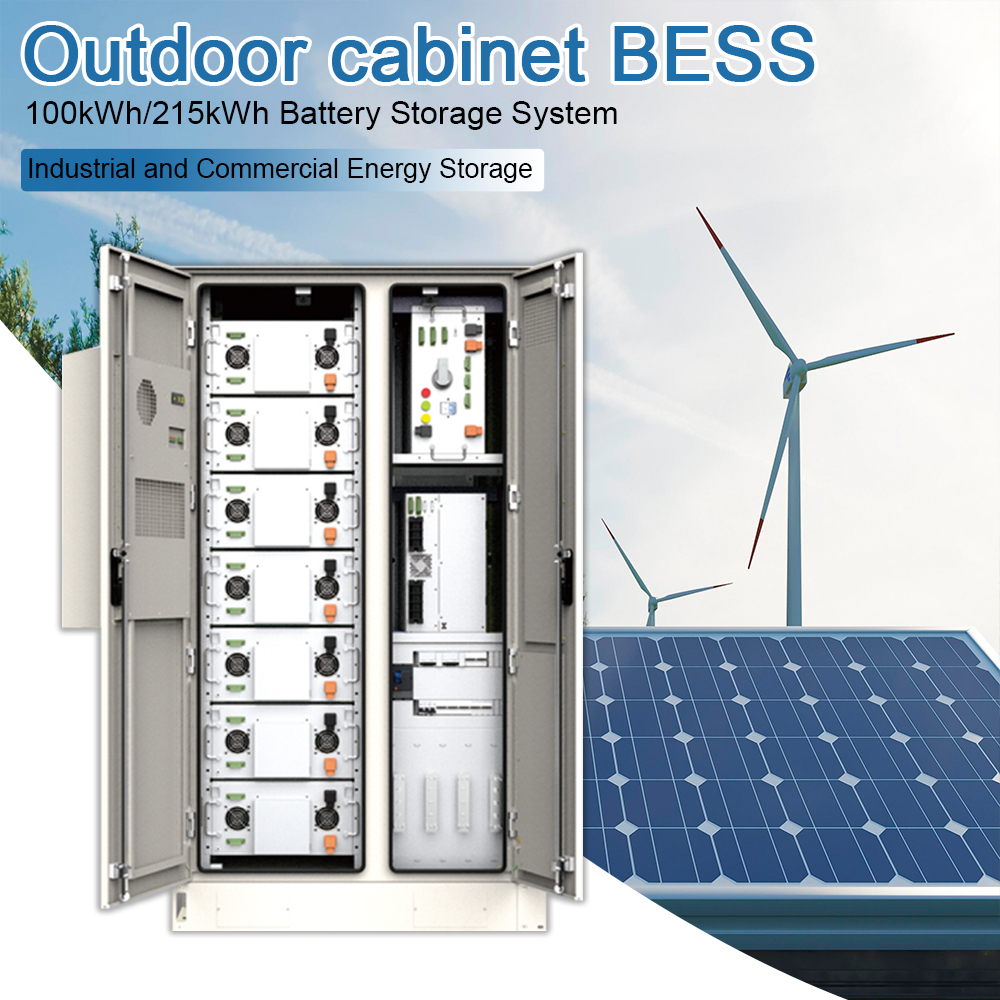What is a BESS System?
Battery Energy Storage Systems (BESS) are transforming the power grid with their reliable and efficient energy storage capabilities. Acting like a massive battery, a BESS consists of multiple battery cells (typically lithium-ion) known for their high efficiency and long lifespan. These cells are connected to power inverters and a sophisticated control system that work together to ensure efficient energy storage.

100kwh BESS System
Types of BESS Systems
BESS systems can be categorized based on their application and scale:
Industrial and Commercial Storage
Used in industrial and commercial settings, these systems include battery storage, flywheel storage, and supercapacitor storage. Key applications include:
- Self-use by industrial and commercial users: Businesses can install BESS systems to store energy generated from renewable sources like solar or wind. This stored energy can be used when needed, reducing grid dependency and lowering electricity costs.
- Microgrids: BESS systems are crucial for microgrids, providing backup power, smoothing grid fluctuations, and enhancing stability and reliability.
- Demand response: BESS systems can participate in demand response programs, charging during low-cost periods and discharging during peak times, helping to balance grid supply and demand and reducing peak-shaving costs.
Grid-scale Storage
These large-scale systems are used in grid applications for peak shaving and enhancing grid security, offering substantial energy storage capacity and power output.
Key Components of a BESS System
- Battery: The core of the BESS, responsible for electrochemical energy storage. Lithium-ion batteries are preferred due to:
- High energy density: They store more energy per unit weight or volume compared to other types.
- Long lifespan: Capable of thousands of charge-discharge cycles with minimal capacity loss.
- Deep discharge capability: They can discharge deeply without damaging the battery cells.
- Inverter: Converts DC power from the batteries into AC power usable by homes and businesses. This enables the BESS to:
- Supply AC power to the grid when needed.
- Charge from the grid during periods of low electricity prices.
- Control System: The intelligent commander of the BESS, continuously monitoring and managing system operations to ensure:
- Optimal battery health and performance: Extending battery life and efficiency.
- Efficient energy flow: Optimizing charge-discharge cycles to maximize storage and use.
- System safety: Protecting against electrical hazards and ensuring safe operation.
How a BESS System Operates
A BESS system operates on a straightforward principle:
- Energy Absorption: During low-demand periods (e.g., nighttime for solar power), the BESS absorbs excess renewable energy from the grid, preventing waste.
- Energy Storage: The absorbed energy is carefully stored electrochemically in the batteries for future use.
- Energy Release: During peak demand, the BESS releases the stored energy back to the grid, ensuring continuous and reliable power supply.
Advantages of BESS Systems
BESS technology offers numerous benefits, significantly transforming the power grid:
- Enhanced grid stability and reliability: Acting as a buffer, BESS mitigates renewable energy generation fluctuations and smooths peak demand periods, resulting in a more stable and reliable grid.
- Increased renewable energy utilization: By storing excess solar and wind energy, BESS maximizes renewable resource use, reducing dependence on fossil fuels and promoting a cleaner energy mix.
- Reduced fossil fuel dependence: Providing clean renewable energy, BESS helps lower greenhouse gas emissions, contributing to a more sustainable environment.
- Cost savings: Strategic energy storage during low-cost periods can reduce overall costs for consumers and businesses by discharging power during peak demand times.
Applications of BESS Systems
As an efficient energy storage technology, BESS systems demonstrate substantial potential across various fields. Their operational models adapt to specific needs based on different scenarios. Here’s an in-depth look at BESS applications in typical settings:
1. Self-use by Industrial and Commercial Users: Energy Savings and Enhanced Energy Independence
For businesses with solar or wind power systems, BESS can help maximize renewable energy use and achieve cost savings.
- Operation Model:
- Daytime: Solar or wind power primarily supplies the load. Excess energy is converted to AC via inverters and stored in the BESS or fed into the grid.
- Nighttime: With reduced solar or wind power, the BESS supplies stored energy, with the grid as a secondary source.
- Advantages:
- Reduced grid dependency and lower electricity costs.
- Increased renewable energy utilization, supporting environmental sustainability.
- Enhanced energy independence and resilience.
2. Microgrids: Reliable Power Supply and Critical Infrastructure Protection
In microgrids, BESS plays a crucial role by providing backup power, smoothing grid fluctuations, and improving stability and reliability, especially in remote or outage-prone areas.
- Operation Model:
- Normal Operation: Distributed generators (e.g., solar, wind, diesel) supply the microgrid, with excess energy stored in the BESS.
- Grid Failure: The BESS quickly releases stored energy to provide backup power, ensuring critical infrastructure operation.
- Peak Load: The BESS supports distributed generators, smoothing grid fluctuations and ensuring stability.
- Advantages:
- Enhanced microgrid stability and reliability, ensuring critical infrastructure operation.
- Reduced grid dependency and increased energy autonomy.
- Optimized distributed generator efficiency, lowering operational costs.
3. Residential Applications: Clean Energy and Smart Living
For households with rooftop solar panels, BESS helps maximize solar energy use, providing clean power and an intelligent energy experience.
- Operation Model:
- Daytime: Solar panels supply household loads, with excess energy stored in the BESS.
- Nighttime: The BESS supplies stored solar energy, supplemented by the grid as needed.
- Smart Control: The BESS integrates with smart home systems to adjust charge-discharge strategies based on user demand and electricity prices for optimal energy management.
- Advantages:
- Reduced grid dependency and lower electricity costs.
- Utilization of clean energy, supporting environmental protection.
- Enhanced smart energy experience, improving quality of life.
Conclusion
BESS systems are a key technology for achieving a cleaner, smarter, and more sustainable energy system. As technology advances and costs decline, BESS systems will play an increasingly important role in creating a brighter future for humanity.